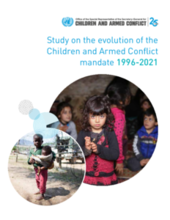The mandate of the Special Representative of the Secretary-General for Children and Armed Conflict (SRSG CAAC) was created by the General Assembly in 1996.4 This followed the publication of the landmark report on the impact of armed conflict on children, prepared by Graça Machel, the expert appointed by Secretary-General Boutros Boutros-Ghali on 8 June 1994, pursuant to General Assembly resolution 48/157 of 20 December 1993. The report was initiated at the recommendation of the Committee on the Rights of the Child in accordance with the provisions of article 45(c) of the Convention on the Rights of the Child. The first SRSG CAAC was Under-Secretary-General Olara Otunnu of Uganda, who was appointed in 1997 by Secretary-General Kofi Annan.
This study looks at the results achieved under the mandate in the past 25 years, the challenges that impacted its implementation and the opportunities to improve the protection of children affected by conflict. It identifies lessons learned and good practices, as well as new working methods that have emerged as a result of specific circumstances, including – but not limited to – the recent coronavirus disease (COVID-19) pandemic. The study further analyses opportunities and risks in engaging with parties to conflict in order to improve the protection of children and prevent grave violations against children from occurring in the first place. Lastly, the study aims to serve as a reference for those of the general public who have an interest in learning more about the mandate and how it has evolved throughout the years, as well as in knowing more about the work of the Office of the SRSG CAAC

